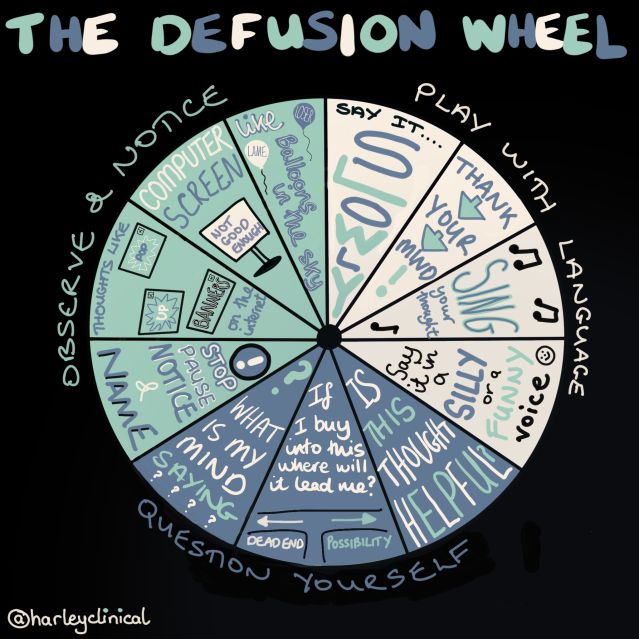If you are an overthinker, you will know how anxiety-provoking it can be to get stuck in thought loops that don’t seem to stop. A central idea of acceptance and commitment therapy (ACT) is that psychological difficulties occur because we rigidly believe the literal content of our minds; we fuse with our internal language/thoughts, leading us to behave in ways that may not be helpful to us. This is called cognitive fusion and can be described in various ways, such as being hooked by your thoughts, being caught up with your thoughts, or buying into your thoughts.
In contrast, defusion is to literally undo fusion (Luoma et al., 2017)—to step back from our thoughts and see them as bits of internal language in our minds. Defusion means that we are looking at our thoughts rather than coming from our thoughts. A sentence is viewed simply as a sentence—a string of words grouped together, rather than a truth to be believed (e.g., I am unlovable) or a command to be obeyed (e.g., I must check the taps again), or a threat to be acted upon (e.g., they can see me blushing so I need to leave).
The Defusion Wheel
The Defusion Wheel is a helpful visual illustration of some key defusion techniques that can help you step back from your unhelpful thoughts and tame overthinking, grouped into categories: observe and notice, play with language, and question yourself.

Source: Dr Liz White at Harley Clinical Psychology
Observe and Notice
One of the first essential steps to helping you step back from your thoughts is to observe and notice your thinking. This can be done in many ways, but all involve shifting your attention to your thoughts.
1. Stop. Pause. Notice and name: Simply stop what you are doing, pause (taking a slow, deep breath can be helpful here), and notice what your mind is saying now. What thoughts or images are showing up? Listen to what is there if you experience your thoughts as sounds (e.g., an internal voice). Then name it: a worry, a prediction, a negative thought, an anxious thought, a judgment, a critical thought, and so on.
2. Thoughts like pop-up banners on the internet: Think of your thoughts as pop-up banners on the internet; try visualising them in your mind’s eye as a pop-up banner. You don’t need to engage with the pop-up if it is unhelpful; recognise that the unhelpful pop-up has shown up, and move your attention to something more meaningful/helpful.
3. Thoughts on a computer screen: Imagine your thoughts as sentences/words or images on your computer or mobile screen like the pop-up banners technique. Play around with the font—make it bigger or smaller, change the colour, turn it into word art, etc. The idea here is to help you observe and notice your thoughts for what they are—consonants, vowels, words, sentences—language in your mind.
4. Balloons in the sky: Imagine that your thoughts are on balloons that are floating in the sky. You can be creative and imagine writing your thoughts on the balloons and letting them go, or maybe they magically appear on them and float into the sky. You don’t need to hang onto the balloons; observe and notice them as you experience each thought.
Play With Language
The aim of defusion is to see your thoughts for what they are—language your mind has produced. Playing with different elements of language can be a good (and often fun!) way to help with this.
5. Say it slowly: Take a difficult thought you are experiencing and say it very slowly. Take your time with it, sounding out each part of the word and sentence.
6. Repeat it quickly: The next time you experience a difficult thought, say it over and over again to yourself quickly, for 30-60 seconds. This classic defusion technique helps you experience your thoughts as sounds that your mouth, tongue, and lips are making.
7. Sing your thoughts: Singing your thoughts to a well-known tune can help you take the power out of difficult thoughts. You can use any familiar tune you like. Classic songs such as “Happy Birthday to You” or “The Grand Old Duke of York” are an excellent place to start.
8. Silly or funny voice: If you experience your thoughts as an internal voice, saying your thoughts in a silly or funny voice can be effective in helping you defuse. For example, say your thoughts to yourself as Daffy Duck or Miss Piggy (or any other cartoon character) or your thoughts as your favourite film or TV character.
Question Yourself
Rather than blindly following what your mind says, take a curious and, where possible, nonjudgmental approach to it. See your mind as an organ in your body that produces thoughts.
9. What is my mind saying? First, try to tune into what your mind is saying. What thoughts are showing up? What are you thinking? It can help to ask yourself: “Right now, what is my mind saying?” or “Hello, mind, what are you trying to tell me?”
10. Is this thought helpful? A really simple question to ask yourself in difficult moments is this: Is this thought helpful to me? Does it help me live the life I want to live? Does it help me be the person I want to be in this moment/situation?
11. If I buy into this thought: Similar to “Is this thought helpful?”, if you buy into whatever your mind is saying (e.g., “I can’t do this work”), where will it lead you? Will you be more likely to give up, get increasingly frustrated, procrastinate, and feel bad about yourself? What would happen if you could step back from the thought, notice you are getting hooked, and identify the helpful actions you can take that will move you toward being someone who can get that piece of work done?
Summary
The Defusion Wheel is a simple tool that combines various techniques to help promote defusion and enable you to be less entangled in your thoughts and, therefore, less overthinking. If you are less dominated by your thoughts, you can start to more easily choose what you’ll do next to help you create a more rich and meaningful life, or a life more in line with your values.
